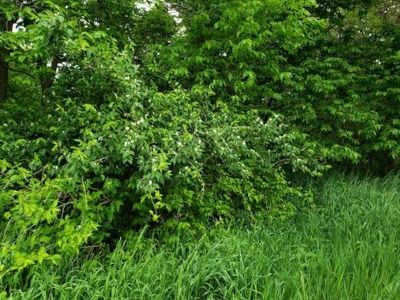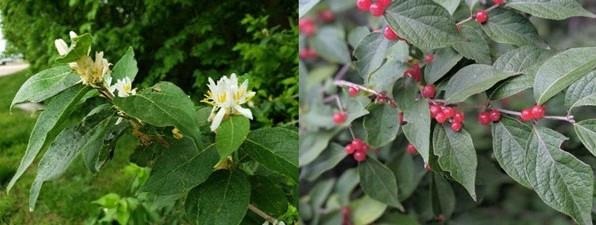Identification
Seedlings emerge throughout the summer. Both Amur and Tatarian honeysuckle have opposite, egg-shaped, hairy leaves (Figure 1). Stems of new growth of Amur honeysuckle is pubescent but new Tatarian honeysuckle stems have no hairs. Mature stems of both species have light brown to gray bark that splits or peels. Stems of Amur honeysuckle grow up to 30 feet tall, while Tatarian honeysuckle grows to about 13 feet tall (Figure 2).

Figure 1. Tatarian honeysuckle seedling.

Figure 2. Amur honeysuckle bush.
Leaves of both species are oppositely arranged and egg-shaped to oblong with entire margins and very few hairs. Amur honeysuckle leaves are about 1 to 4 inches long, while Tatarian honeysuckle leaves reach up to about 2 1/2 inches long (Tatarian).
Both species produce pairs of flowers, about ¾-inch long, in April through June. Amur honeysuckle flowers are white to yellow and Tatarian honeysuckle flowers are pink to white. Red berries, about ¼-inch in diameter, form in late summer and persist through winter. (Figure 3).
 Figure 3. Amur honeysuckle flowers (left) and berries (right).
Figure 3. Amur honeysuckle flowers (left) and berries (right).
Management
Foliar applications of triclopyr (Remedy Ultra, others) or glyphosate applied in early spring or fall can control bush honeysuckles; however, these herbicides will damage other sensitive plants that are sprayed.
Cutting or mowing bush honeysuckles will not be effective, unless regrowth is prevented with a cut stump herbicide application. Glyphosate is effective for that type of application. Prescribed burning in the spring may control seedlings of bush honeysuckles, but established plants will readily re-sprout.
The use of trade names is for clarity to readers and does not imply endorsement of a particular product, nor does exclusion imply non-approval. Always consult the herbicide label for the most current use requirements.
Source : ksu.edu